Mechanical Properties and Strength Reliability of Impregnated Wood after High Temperature Conditions
Abstract
1. Introduction
2. Material and Research Method
- t—generalized time,
- b—parameter of scale,
- c—parameter of shape,
- —parameter of location, (0 for the 2-parameter Weibull distribution, which is explained in the discussion on the research results).
- t—generalized time,
- b—parameter of scale,
- c—parameter of shape.
3. Results of Research and Discussion
3.1. Results of the Strength and Modulus of Elasticity in Tension Tests
3.2. Results of Structural Reliability Tests
3.3. Discussion
4. Conclusions
- The results of this type of research identify the effect of impregnation and an impregnation method on the performance of wood. The strength and reliability of wood impregnated with the nanoparticle agent is greater, probably due to impregnation from the upper layer of wood towards the core as well as its sealing. Degradation of silicon dioxide is long-term, but it is an inorganic compound commonly found in the Earth as a mineral, rock constituent and of a low environmental impact.
- Thermal properties of silica are not insignificant in fire protection, e.g., its high melting point, low thermal conductivity.
- The applied impregnant improves the strength reliability of solid wood tested in our research.
Author Contributions
Funding
Conflicts of Interest
References
- Lionetto, F.; Frigione, M. Mechanical and natural durability properties of wood treated with a novel organic preservative/consolidant product. Mater. Des. 2009, 30, 3303–3307. [Google Scholar] [CrossRef]
- Devi, R.R.; Maji, T.K. Interfacial effect of surface modified TiO2 and SiO2 nanoparticles reinforcement in the properties of wood polymer clay nanocomposites. J. Taiwan Inst. Chem. Eng. 2013, 44, 505–514. [Google Scholar] [CrossRef]
- Keskin, H. Impact of impregnation chemical on the bending strength of solid and laminated wood materials. Mater. Des. 2009, 30, 796–803. [Google Scholar] [CrossRef]
- Tomak, E.D.; Baysal, E.; Peker, H. The effect of some wood preservatives on the thermal degradation of Scots pine. Thermochim. Acta 2012, 547, 76–82. [Google Scholar] [CrossRef]
- Zobel, H.; Alkhafaji, T. Mosty Drewniane: Konstrukcje Przełomu XX i XXI Wieku; Wydawnictwa Komunikacji i Łączności: Warsaw, Poland, 2006. [Google Scholar]
- Richardson, B.A. Wood Preservation; The Construction Press: Lancaster, UK, 1978. [Google Scholar]
- Atar, M.; Colakoglu, M.H. Surface Adhesion Strength of Varnishes in Some Impregnated Woods. J. Appl. Sci. 2009, 9, 4066–4070. [Google Scholar] [CrossRef]
- Simsek, H.; Baysal, E.; Peker, H. Some mechanical properties and decay resistance of wood impregnated with environmentally-friendly borates. Constr. Build. Mater. 2010, 24, 2279–2284. [Google Scholar] [CrossRef]
- Oszust, M.; Pieniak, D.; Ogrodnik, P.; Dec, L. The investigation of immediate strength loss of thermally modified spruce timber under fire temperatures. Drewno 2011, 54, 97–108. [Google Scholar]
- Gunduz, G.; Aydemir, D.; Karakas, G. The effects of thermal treatment on the mechanical properties of wild Pear (Pyrus elaeagnifolia Pall.) wood and changes in physical properties. Mater. Des. 2009, 30, 4391–4395. [Google Scholar] [CrossRef]
- Bednarek, Z.; Kaliszuk-Wietecka, A. Analysis of the fire-protection impregnation influence on wood strength. J. Civ. Eng. Manag. 2007, 13, 79–85. [Google Scholar] [CrossRef]
- Szymczak, C. Elementy Teorii Projektowania; Wydawnictwo Naukowe PWN: Warsaw, Poland, 1998. [Google Scholar]
- Grabski, F.; Jaźwiński, J. Funkcje o Losowych Argumentach w Zagadnieniach Niezawodności, Bezpieczeństwa i Logistyki; Wydawnictwa Komunikacji i Łączności: Warsaw, Poland, 2009. [Google Scholar]
- Korkut, S.; Akgül, M.; Dündar, T. The effects of heat treatment on some technological properties of Scots pine (Pinus sylvestris L.) wood. Bioresour. Technol. 2008, 99, 1861–1868. [Google Scholar] [CrossRef]
- Nagrodzka, M.; Małozięć, D. Impregnation of the wood by flame retardants. Bezp. I Tech. Pozar. 2011, 23, 69–75. [Google Scholar]
- Wazny, J. Investigations of the influence of wood preservatives on strength. Dreviesiny Sreda 1973, 3, 181. [Google Scholar]
- Bendtsen, B.A. Mechanical Properties of Longleaf Pine Treated with Waterborne Salt Preservatives; US Department of Agriculture, Forest Service, Forest Products Laboratory: Madison, WI, USA, 1983; Volume 434. [Google Scholar]
- Gałaj, J.; Drzymała, T.; Wolny, P. Analysis of the Impact of Selected Parameters of the Hybrid Extinguishing System on the Fire Environment in a Closed Room. Sustainability 2019, 11, 6867. [Google Scholar] [CrossRef]
- Czechowski, A. Wybrane terminy i definicje związane z analizą i projektowaniem konstrukcji budowlanych, zwłaszcza metalowych. Inż. Bud. 2016, 72, 563–568. [Google Scholar]
- Bartnik, G.; Marciniak, A.; Gołacki, K. Application of CLP for technical objects construction with an exemplary bucket elevation. In ITM Web of Conferences; EDP Sciences: Les Ulis, France, 2018; Volume 21, p. 3. [Google Scholar]
- Pytka, J.; Budzyński, P.; Łyszczyk, T.; Józwik, J.; Michałowska, J.; Tofil, A.; Laskowski, J. Determining Wheel Forces and Moments on Aircraft Landing Gear with a Dynamometer Sensor. Sensors 2020, 20, 227. [Google Scholar] [CrossRef] [PubMed]
- Pytka, J.; Budzyński, P.; Józwik, J.; Michałowska, J.; Tofil, A.; Łyszczyk, T.; Błażejczak, D. Application of GNSS/INS and an Optical Sensor for Determining Airplane Takeoff and Landing Performance on a Grassy Airfield. Sensors 2019, 19, 5492. [Google Scholar] [CrossRef]
- Pieniak, D.; Przystupa, K.; Walczak, A.; Niewczas, A.M.; Krzyzak, A.; Bartnik, G.; Lonkwic, P. Hydro-thermal fatigue of polymer matrix composite biomaterials. Materials 2019, 12, 3650. [Google Scholar] [CrossRef]
- Przystupa, K. Wybór punktów krytycznych w systemie HACCP. Przem. Spoż. 2013, 67, 42–46. [Google Scholar]
- Murzewski, J. Design of steel structures for differentiated reliability levels. Arch. Civ. Eng. 2008, 54, 209–237. [Google Scholar]
- Nowak, A.S.; Collins, K.R. Reliability of Structures; CRC Press: Boca Raton, FL, USA, 2012. [Google Scholar]
- Walczak, A.; Pieniak, D.; Niewczas, A.; Niewczas, A.M.; Kordos, P. Study of ceramic-polymer composites reliability based on the bending strength test. J. Konbin 2015, 35, 169–178. [Google Scholar] [CrossRef][Green Version]
- Sun, S.; Przystupa, K.; Wei, M.; Yu, H.; Ye, Z.; Kochan, O. Fast bearing fault diagnosis of rolling element using Lévy Moth-Flame optimization algorithm and Naive Bayes. Eksploat. I Niezawodn. 2020, 22, 730. [Google Scholar] [CrossRef]
- Warszyński, M. Niezawodność w Obliczeniach Konstrukcyjnych; Państwowe Wydawnictwo Naukowe: Warsaw, Poland, 1988. [Google Scholar]
- Atar, M. Effects of impregnation with Imersol-AQUA on the bending strength of some wood materials. Mater. Des. 2008, 29, 1707–1712. [Google Scholar] [CrossRef]
- Montgomery, D.C. Introduction to Statistical Quality Control; John Wiley & Sons: Hoboken, NJ, USA, 2007. [Google Scholar]
- Kaplan, E.L.; Meier, P. Nonparametric estimation from incomplete observations. J. Am. Stat. Assoc. 1958, 53, 457–481. [Google Scholar] [CrossRef]
- Zhang, T.; Xie, M. On the upper truncated Weibull distribution and its reliability implications. Reliab. Eng. Syst. Saf. 2011, 96, 194–200. [Google Scholar] [CrossRef]
- Hill, T.; Lewicki, P.; Lewicki, P. Statistics: Methods and Applications: A Comprehensive Reference for Science, Industry, and Data Mining; StatSoft, Inc.: Tulsa, OK, USA, 2006. [Google Scholar]
- Ewens, W.J.; Grant, G.R. Statistical Methods in Bioinformatics: An Introduction; Springer Science & Business Media: Berlin/Heidelberg, Germany, 2006. [Google Scholar]
- Walczak, A.; Pieniak, D.; Oszust, M.; Blukacz, M.; Ogrodnik, P. Badanie porównawcze efektu skali w próbie ściskania drewna modyfikowanego. Autobusy Tech. Eksploat. Syst. Transp. 2014, 15, 122–126. [Google Scholar]
- Fang, C.H.; Mariotti, N.; Cloutier, A.; Koubaa, A.; Blanchet, P. Densification of wood veneers by compression combined with heat and steam. Eur. J. Wood Wood Prod. 2012, 70, 155–163. [Google Scholar] [CrossRef]
- Kartal, S.N.; Hwang, W.J.; Yamamoto, A.; Tanaka, M.; Matsumura, K.; Imamura, Y. Wood modification with a commercial silicon emulsion: Effects on boron release and decay and termite resistance. Int. Biodeterior. Biodegrad. 2007, 60, 189–196. [Google Scholar] [CrossRef]
- Kartal, S.N.; Yoshimura, T.; Imamura, Y. Modification of wood with Si compounds to limit boron leaching from treated wood and to increase termite and decay resistance. Int. Biodeterior. Biodegrad. 2009, 63, 187–190. [Google Scholar] [CrossRef]
- Manríquez, M.J.; Moraes, P.D. Influence of the temperature on the compression strength parallel to grain of paricá. Constr. Build. Mater. 2010, 24, 99–104. [Google Scholar] [CrossRef]
- Soti, R.; Knight, C.; Mageshwar, S.; Valluri, S.D.; Sinha, A. Effect of Elevated Temperature Exposures on Shear Properties of Sheathing Panels. For. Prod. J. 2020, 70, 115–121. [Google Scholar]
- Bhuiyan, M.T.R.; Hirai, N.; Sobue, N. Changes of crystallinity in wood cellulose by heat treatment under dried and moist conditions. J. Wood Sci. 2000, 46, 431–436. [Google Scholar] [CrossRef]
- Sivonen, H.; Maunu, S.L.; Sundholm, F.; Jämsä, S.; Viitaniemi, P. Magnetic resonance studies of thermally modified wood. Holzforschung 2002, 56, 648–654. [Google Scholar] [CrossRef]
- Niewczas, A.M.; Pieniak, D.; Ogrodnik, P. Reliability analysis of strength of dental composites subjected to different photopolymerization procedures. Eksploat. Niezawodn. 2012, 14, 249–255. [Google Scholar]
- Schaffer, E.L. Effect of pyrolytic temperatures on the longitudinal strength of dry Douglas-fir. J. Test. Eval. 1973, 1, 319–329. [Google Scholar]
- Murzewski, J. Niezawodność Konstrukcji Inżynierskich; Arkady: Warsaw, Poland, 1989. [Google Scholar]
- Migdalski, J. Poradnik Niezawodności: Praca Zbiorowa. Podstawy Matematyczne; Wema: Warsaw, Poland, 1982. [Google Scholar]
- Jiang, R.; Murthy, D.N.P. A study of Weibull shape parameter: Properties and significance. Reliab. Eng. Syst. Saf. 2011, 96, 1619–1626. [Google Scholar] [CrossRef]
- Bažant, Z.P. Probability distribution of energetic-statistical size effect in quasibrittle fracture. Probab. Eng. Mech. 2004, 19, 307–319. [Google Scholar] [CrossRef]
- Syroka-Korol, E.; Tejchman, J.; Mróz, Z. FE calculations of a deterministic and statistical size effect in concrete under bending within stochastic elasto-plasticity and non-local softening. Eng. Struct. 2013, 48, 205–219. [Google Scholar] [CrossRef]
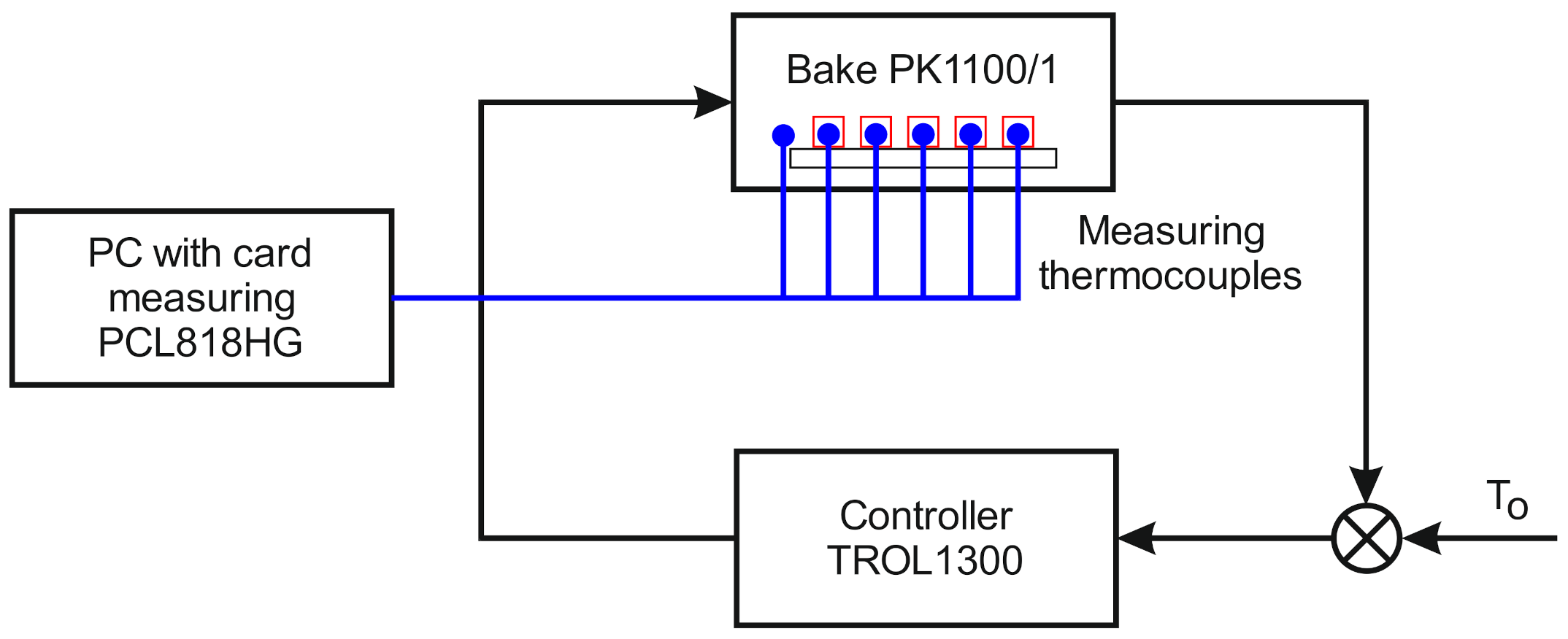
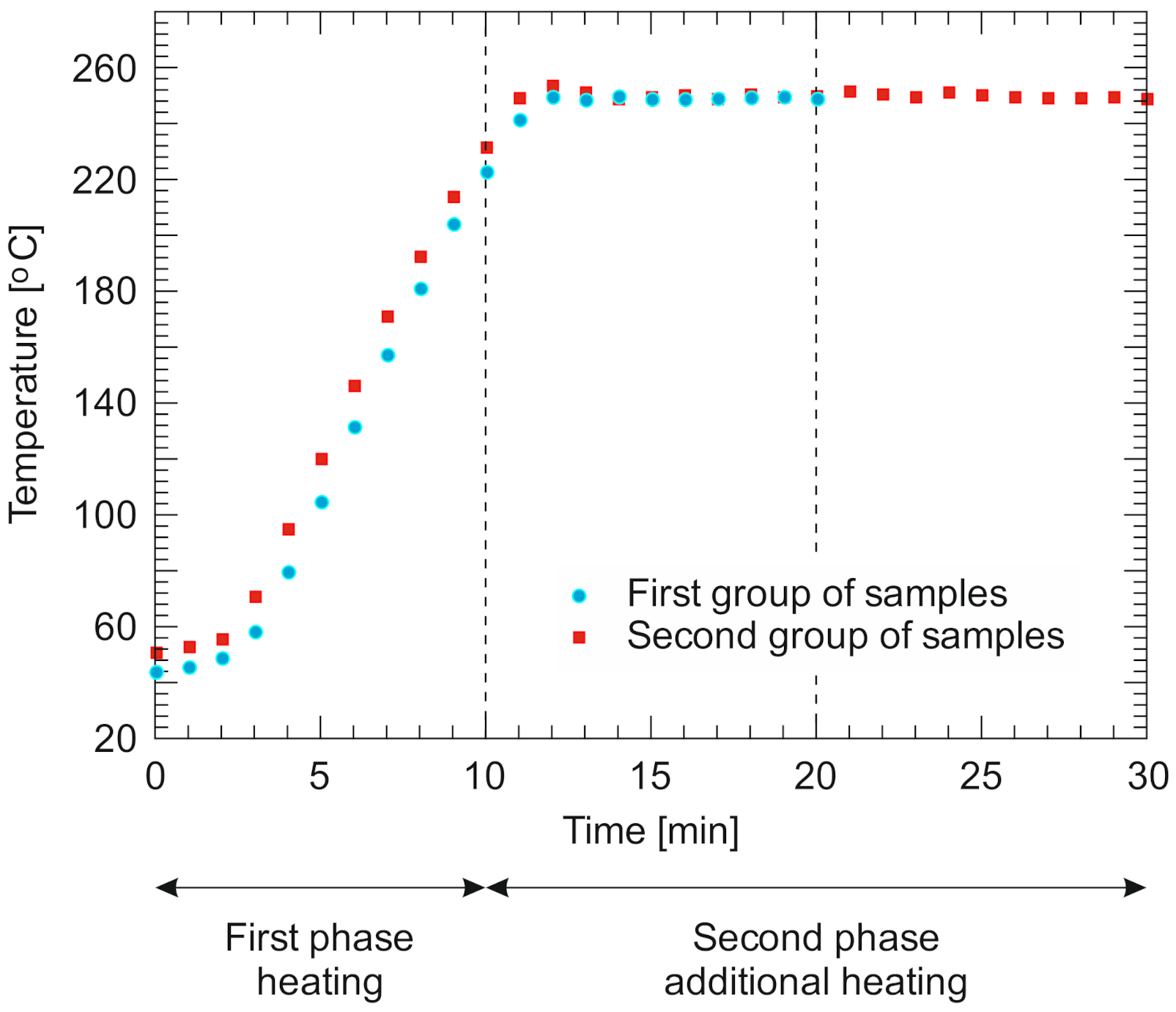
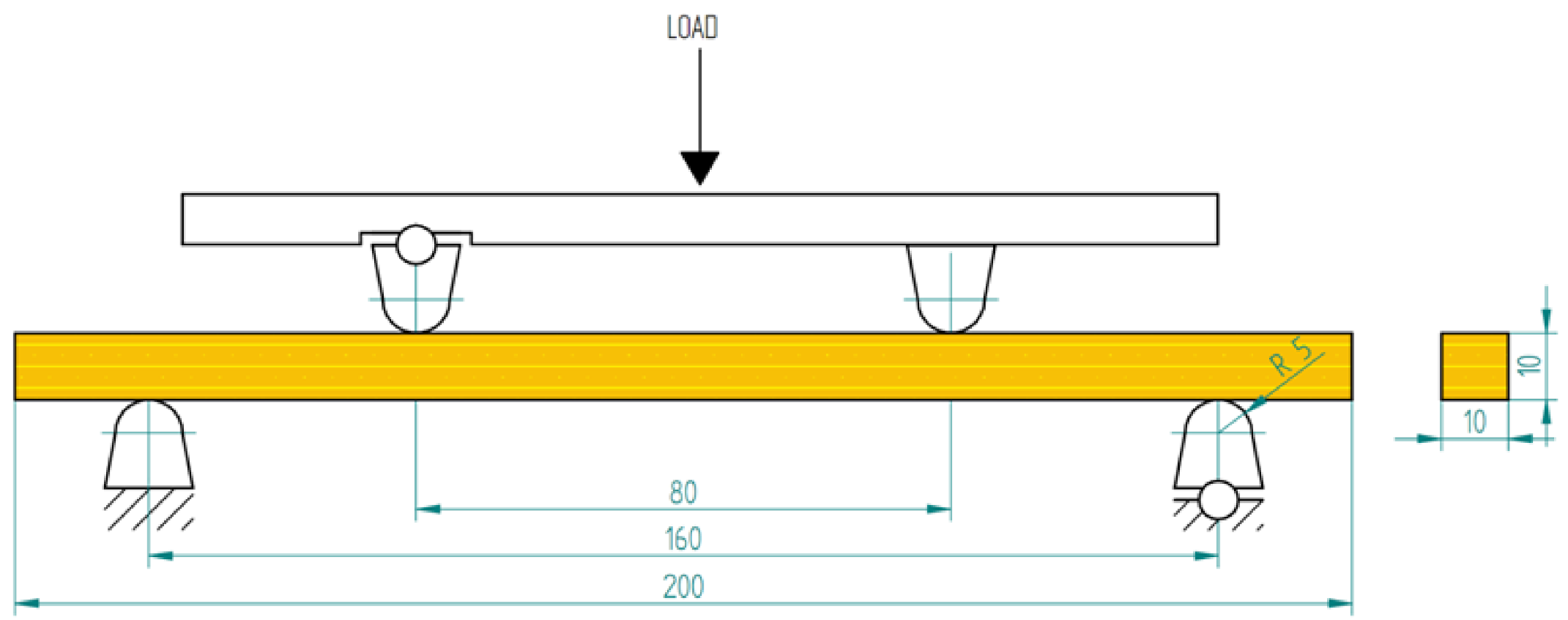
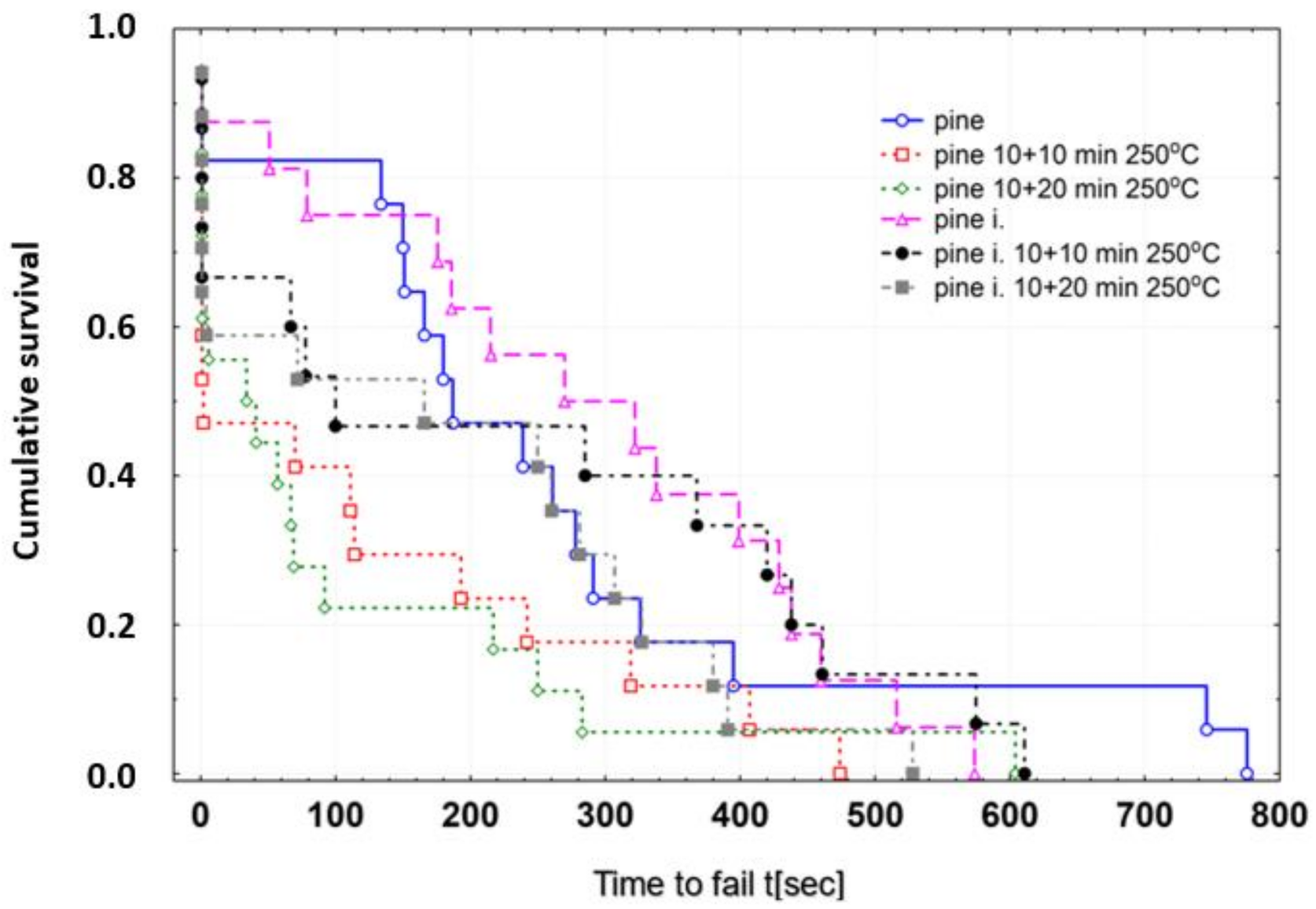
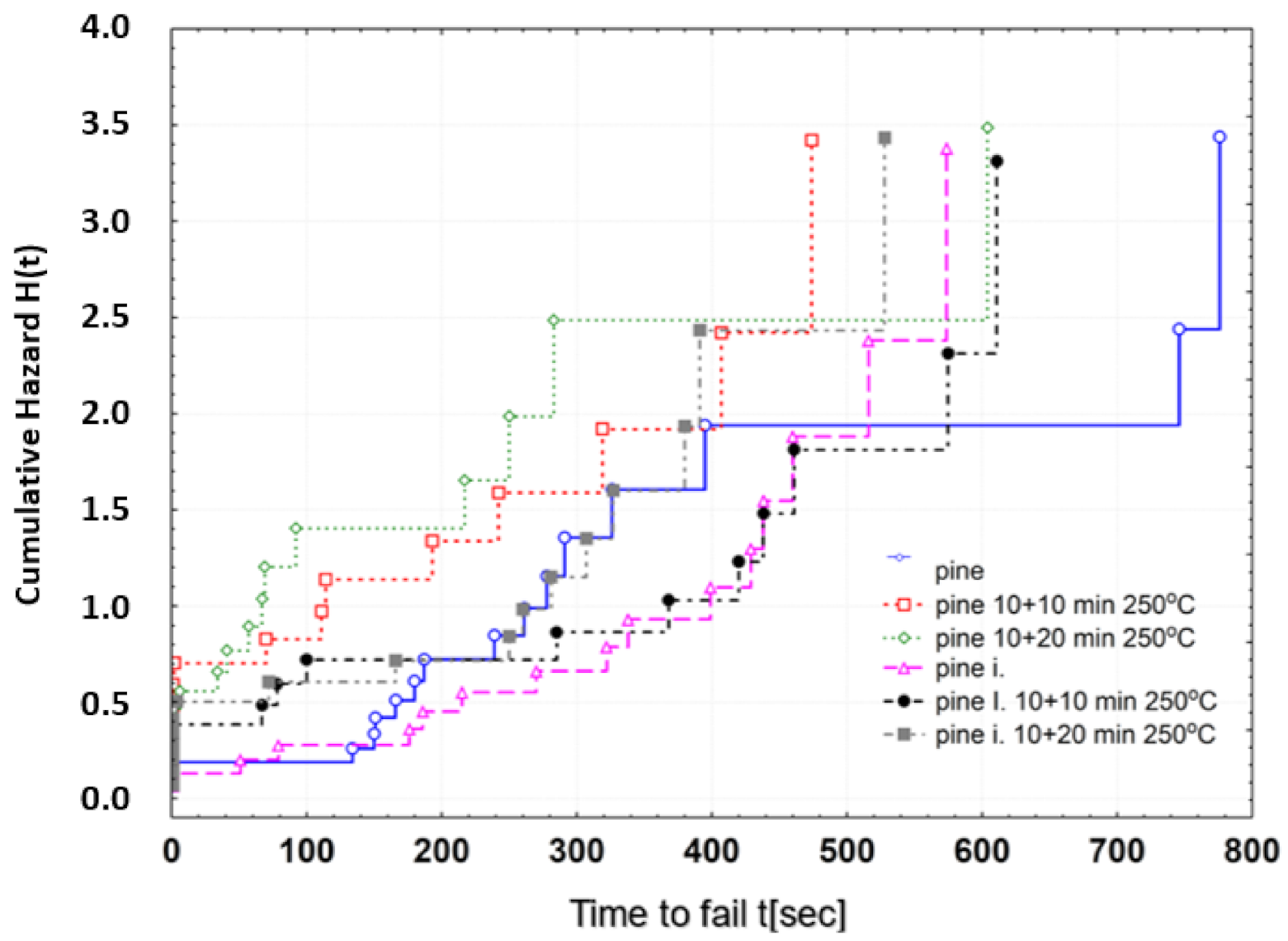
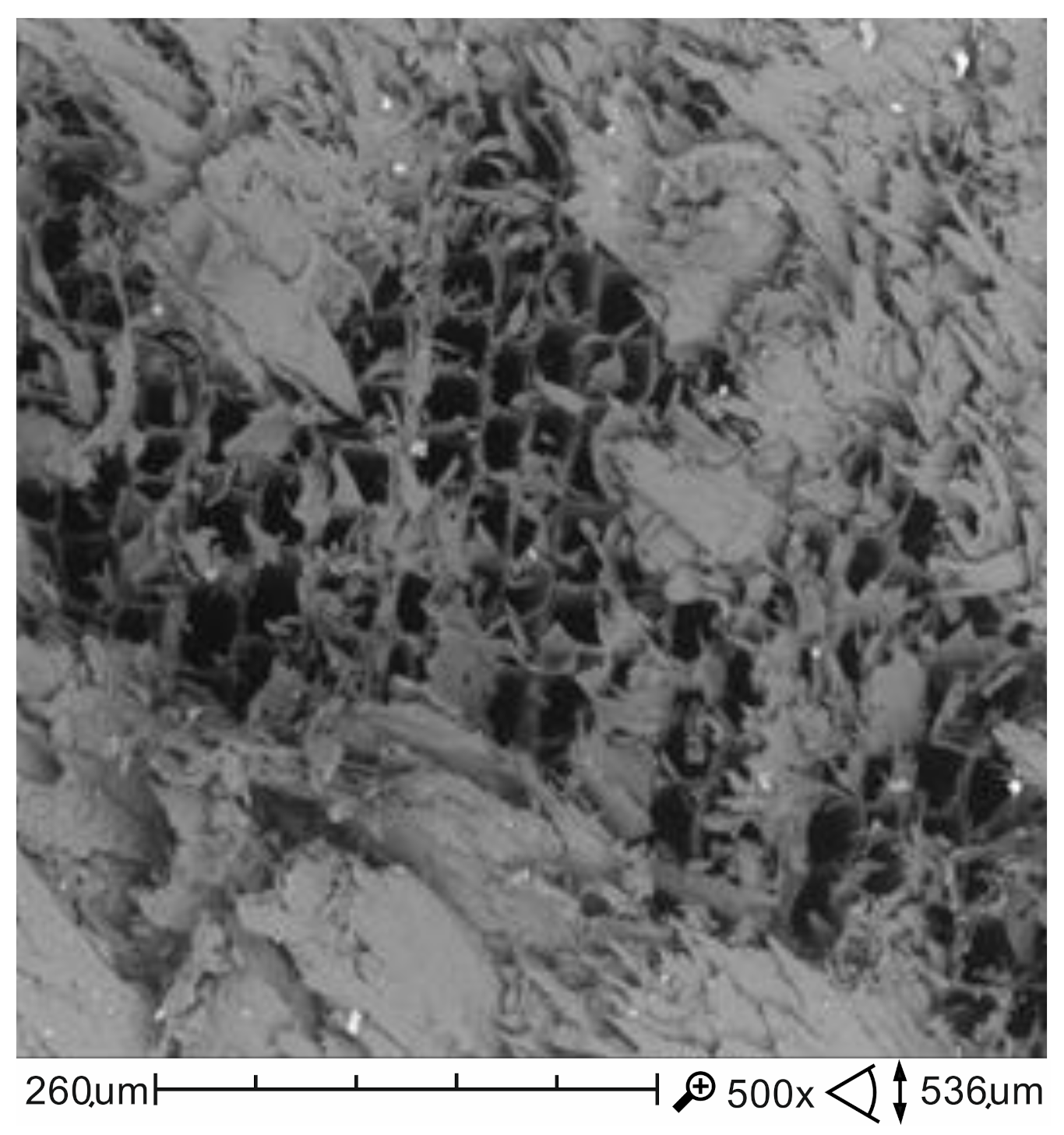
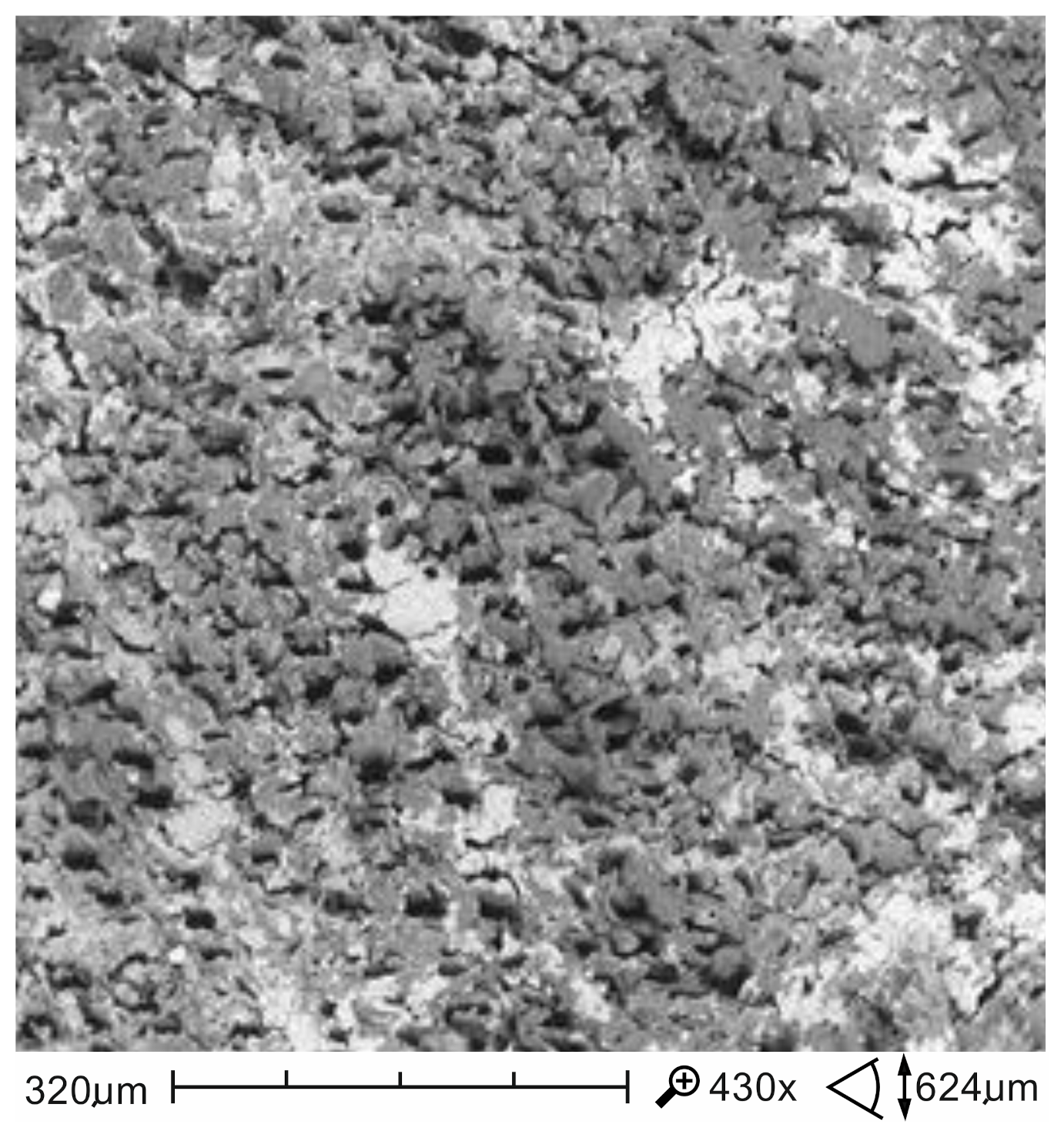
| Properties of the Impregnant | Description/Value |
|---|---|
| View | White powder |
| Scent | None |
| Particle size | 10–20 nm |
| Initial melting point | 1600 °C |
| Initial boiling point | 2300 °C |
| Volumetric density | 0.011 g/mL |
| Parameter | Material (N = 15) | Temp. [°C] | Exp. Time [min] | Mean [GPa] | S.dev. [MPa] | C.var. [%] |
|---|---|---|---|---|---|---|
| E [GPa] | Pine wood | 20 | - | 9.04 | 0.99 | 11.05 |
| 250 | 10 + 10 | 7.85 | 1.71 | 21.77 | ||
| 250 | 10 + 20 | 7.51 | 1.51 | 20.10 | ||
| Pine wood, SiO2 impregnated | 20 | - | 8.93 | 0.806 | 9.03 | |
| 250 | 10 + 10 | 7.67 | 1.48 | 19.29 | ||
| 250 | 10 + 20 | 7.68 | 1.49 | 19.46 | ||
| B [MPa] | Pine wood | 20 | - | 77.7 | 8.93 | 11.50 |
| 250 | 10 + 10 | 41.9 | 14.0 | 33.48 | ||
| 250 | 10 + 20 | 37.5 | 9.19 | 24.53 | ||
| Pine wood, Si O2 impregnated | 20 | - | 81.4 | 5.25 | 6.45 | |
| 250 | 10 + 10 | 47.8 | 14.0 | 29.30 | ||
| 250 | 10 + 20 | 43.5 | 12.1 | 27.91 | ||
| A0 [mm2] | Pine wood | 20 | - | 100.12 | 0.43 | |
| 250 | 10 + 10 | 95.23 | 1.9 | 1.99 | ||
| 250 | 10 + 20 | 95.36 | 1.11 | 1.17 | ||
| Pine wood, Si O2 impregnated | 20 | - | 102.04 | 0.83 | 0.82 | |
| 250 | 10 + 10 | 96.95 | 1.05 | 1.09 | ||
| 250 | 10 + 20 | 96.27 | 1.2 | 1.25 |
| Material | Temp. [°C] | Exp. Time [min] | Shape | Scale |
|---|---|---|---|---|
| Pine wood | 20 | - | 0.431 | 322.02 |
| 250 | 10 + 10 | 0.317 | 50.33 | |
| 250 | 10 + 20 | 0.387 | 49.984 | |
| Pine wood, SiO2 impregnated | 20 | - | 0.495 | 382.66 |
| 250 | 10 + 10 | 0.335 | 169.80 | |
| 250 | 10 + 20 | 0.332 | 119.05 |
Publisher’s Note: MDPI stays neutral with regard to jurisdictional claims in published maps and institutional affiliations. |
© 2020 by the authors. Licensee MDPI, Basel, Switzerland. This article is an open access article distributed under the terms and conditions of the Creative Commons Attribution (CC BY) license (http://creativecommons.org/licenses/by/4.0/).
Share and Cite
Przystupa, K.; Pieniak, D.; Samociuk, W.; Walczak, A.; Bartnik, G.; Kamocka-Bronisz, R.; Sutuła, M. Mechanical Properties and Strength Reliability of Impregnated Wood after High Temperature Conditions. Materials 2020, 13, 5521. https://doi.org/10.3390/ma13235521
Przystupa K, Pieniak D, Samociuk W, Walczak A, Bartnik G, Kamocka-Bronisz R, Sutuła M. Mechanical Properties and Strength Reliability of Impregnated Wood after High Temperature Conditions. Materials. 2020; 13(23):5521. https://doi.org/10.3390/ma13235521
Chicago/Turabian StylePrzystupa, Krzysztof, Daniel Pieniak, Waldemar Samociuk, Agata Walczak, Grzegorz Bartnik, Renata Kamocka-Bronisz, and Monika Sutuła. 2020. "Mechanical Properties and Strength Reliability of Impregnated Wood after High Temperature Conditions" Materials 13, no. 23: 5521. https://doi.org/10.3390/ma13235521
APA StylePrzystupa, K., Pieniak, D., Samociuk, W., Walczak, A., Bartnik, G., Kamocka-Bronisz, R., & Sutuła, M. (2020). Mechanical Properties and Strength Reliability of Impregnated Wood after High Temperature Conditions. Materials, 13(23), 5521. https://doi.org/10.3390/ma13235521






